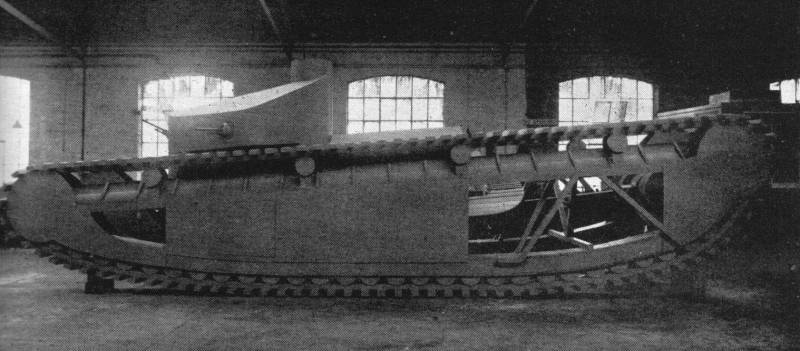Medium tank Medium Tank Mark D (UK)
August 4 20179
First Tankswho entered the battlefields of the First World War, had a noticeable impact on the course of battles and demonstrated the need for such equipment. However, the armored vehicles of the early models did not differ in high performance and had a lot of other disadvantages. Soon new projects of military equipment appeared, which took into account the experience of operating existing tanks, and also offered some new ideas. Noticeable footprint stories British tank building left medium tank Medium Tank Mark D.
By the middle of the 1918, the British Army had tanks of several classes and types, differing from each other in different characteristics and combat capabilities. For example, heavier “diamonds” could show high maneuverability on rough terrain, while light tanks differed more speed. At the same time, a significant part of the machines carried a relatively weak reservation and was equipped only with machine guns. The study of operating experience of all existing tanks soon led to the formation of new concepts and the emergence of promising architectures of armored vehicles.
AD
BMW 320d Automatik Diesel. 7 890 €
AD
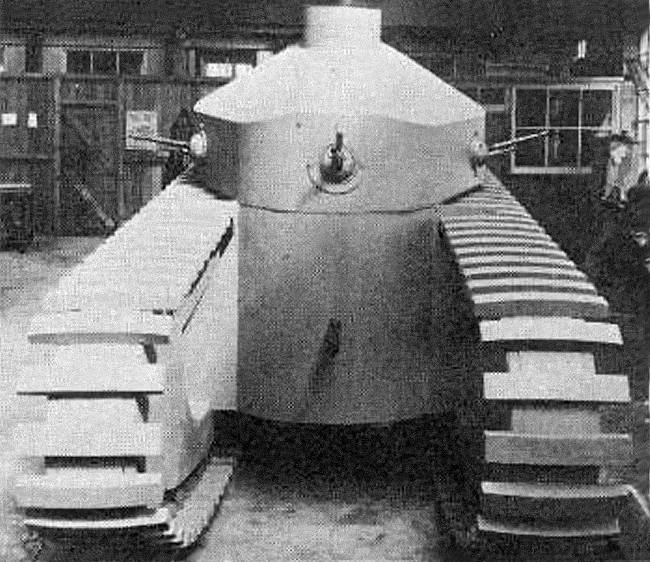
Wooden dummy tank Medium Tank Mark D
Almost no one doubted that the best solution to the existing problems is medium tanks, which combine the high mobility of light equipment and the combat qualities of heavy vehicles. In this regard, in the second half of 1918, several similar projects were launched at once. One of them received the designation Medium Tank Mark D - “Medium Tank, Type D”. Interestingly, the work on the “D” project started in October of 1918, i.e. just a few weeks before the end of the war. As a result, the tank quickly lost all chances to enter the battlefield, but the project was still not stopped and reached the test.
The advanced tank had special requirements in terms of mobility and firepower. The machine had to overcome moats of at least 3 m width and be able to attack targets in any direction. The solution of such problems led to the formation of an unusual technical appearance of the tank. Even against the background of other “land ships” of its time, the new Medium Tank Mark D looked very remarkable and unusual. At the same time, however, some familiar solutions from the modern point of view should have been used in the project.
The main ideas of the project were worked out in the last months of 1918, thanks to which a full-size wooden layout appeared in November. Based on the results of the inspection of this product, the necessary modifications were identified, after which the project was changed as required. The hull underwent some changes, the composition of the onboard units changed slightly. Other original technical solutions were not recycled.
The Medium Tank Mark D project proposed the construction of a sufficiently large combat vehicle capable of showing high maneuverability on rough terrain. To solve these problems, designers have developed a new undercarriage, which had little resemblance to existing systems. So, to overcome the wide trenches, it was proposed to use a tracked propulsion unit with the highest possible base. Overall permeability improved due to non-standard track construction.
The main element of the medium tank “D” was the armor hull of the original design. The body was assembled from armor plates with a thickness of 8-10 mm. With the help of bolts and rivets, individual sheets were mounted on a frame assembled from metal profiles. The layout of the case was close to that which is now called the classic. The habitable volume was located in the front of the hull, combining in itself the control and combat compartments. Large aft compartment was given under the power plant and transmission. At the same time, the machine did not have a swinging tower, instead of which a large fixed wheelhouse was used.
The tank hull received a relatively narrow and high curved frontal sheet. On its sides, beams and shields were fastened on it, which are necessary for moving the undercarriage elements forward relative to the hull. According to some data, the hull was distinguished by the presence of onboard volumes located inside the tracks. At the same time he had a vertical side of a great length. In front of the hull, the roof was absent, because on this place there was a deckhouse with weapons. In the stern there was a cover of the engine compartment, made in the form of a truncated pyramid of small height. The stern was made of several armor plates located at different angles to the vertical.
To accommodate weapons it was proposed to use a fixed wheelhouse placed in the frontal part of the body. Its front part was flush with the front sheet of the case and repeated its shape. The side cuttings performed curved. Due to this, they prominently protruded beyond the main body part and formed a kind of fencing niches. The stern of the tower also had a rounded shape, and this sheet differed from the others in increased height. In this regard, the cabin has received a curved roof with a raised aft, in which there was a small turret with observation slots.
The central and aft parts of the hull were given for installation of the power plant and transmission. Since the tank was distinguished by its large size and weight, it needed an appropriate engine. However, there was no shortage of free volumes for the installation of a powerful power plant. The Medium D tank was equipped with an Armstrong Siddley Puma carburetor engine rated at 240 hp. The engine was connected to a mechanical transmission of a relatively simple design required to drive the rear drive wheels.
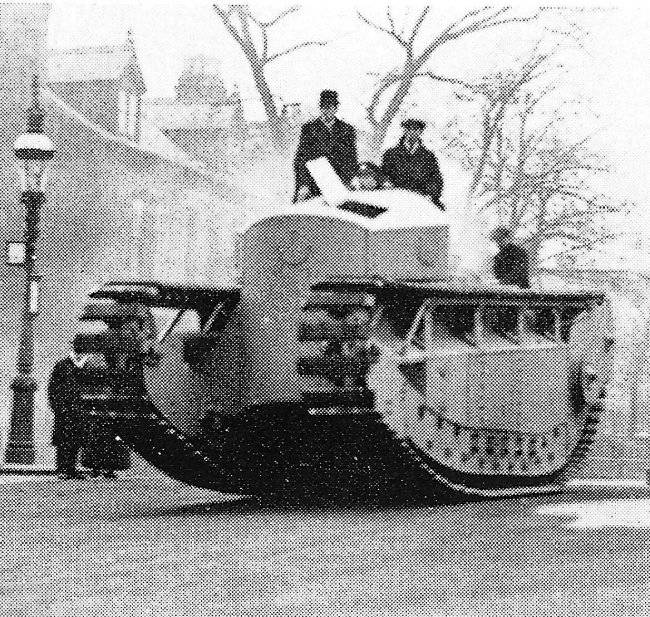
Tank “D” during a demonstration race
One of the objectives of the project was to increase the terrain. To solve it, it was proposed to use the original chassis design, which resembled existing systems, but at the same time it had some noticeable differences. At the bottom of each side using the so-called. The cable suspension was installed on 28 small-diameter support rollers. At the same time, the base beam of the rollers was made curved, because of which only part of the rollers rested on the ground, while the others were normally raised above it and served as tension ones. Also, the tank received support rollers uncharacteristic for British armored cars of that era, five on each side. In the front and rear parts of the board were placed the guides and drive wheels of large diameter. All the main parts of the chassis were covered with armor side shields.
Tank Medium Tank Mark D has received a new caterpillar of unusual design. Instead of a single cast truck, a so-called system was used. skeletal type. The basis of such a caterpillar was a narrow metal chain, to which large width tracks were attached. This made it possible to obtain an acceptable support surface with a minimum assembly weight.
All the weapons of the prospective medium tank were to be located in the forward cabin of the hull. Various variants of the armament complex were considered, involving the use of machine guns and cannons. The most powerful complex was supposed to include the 57-mm gun and two rifle-caliber machine guns. However, this version of the weapon did not come off the blueprints, and the experimental equipment received a less powerful weapon.
Three ball mounts for machine guns were located in the center of the frontal cuttings and in the boards. It was proposed to use 7,7-mm machine guns Hotchkiss. The design of machine-gun environments allowed shelling targets within fairly wide sectors in the forward hemisphere and on the side of the tank. The task of quickly transferring fire to large angles could be solved by simultaneously using different machine guns. Ammunition in the form of several thousand cartridges should be transported inside the habitable compartment on the appropriate racks.
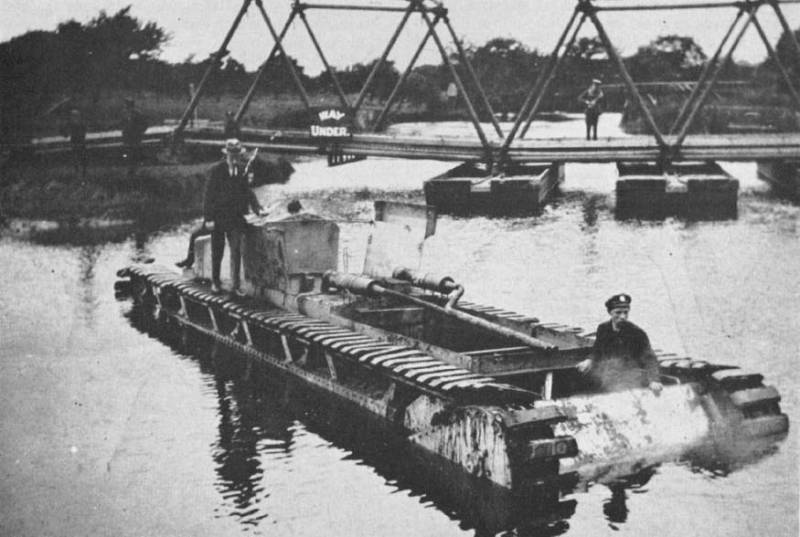
Tank on the water. Part of parts removed to facilitate construction.
According to known data, the crew of the medium tank “D” was to consist of four people. The car was driven by a driver, his assistant, the commander and the shooter. The jobs of the entire crew were located in the front manned compartment of the hull and were not separated from each other. The driver and his assistant were located in the front part of the compartment and could observe the road with roof hatches or viewing slots in the front plate. The commander was located in the aft of the cabin and used a turret with viewing slits. To access the inside of the tank, the driver and commander’s hatches were used. In addition, on the left side of the hull placed another round hatch.
Regardless of the situation and the current situation, the driver had to drive a tank. The main task of his assistant was to monitor the operation of the power plant. The commander, first of all, was to observe the battlefield and look for targets. Shooter serviced weapons. Under appropriate circumstances, the assistant driver and the commander could help the shooter and take control of two machine guns. Thus, the crew had at least the theoretical possibility of simultaneous use of all available weapons.
The original chassis, adapted to overcome obstacles, had a significant impact on the dimensions of the tank. The total length of the Medium Tank Mark D reached 9,15 m. The width did not exceed 2,2 m, the height was no more than 2,5 m. The combat weight was 13,5 t. The relatively high power density (slightly less than 18 hp per ton) made it possible to accelerate to 35- 37 km / h on a good road. Power reserve was 170 km. The tank could climb a wall about 1 m high and cross a trench wider than 3 m.
The prospective tank was distinguished by large internal volumes filled with air. As a result, it had limited buoyancy and could cross water barriers not only by fords. However, the real characteristics of the water were not too high and imposed significant restrictions on the intersection of water bodies.
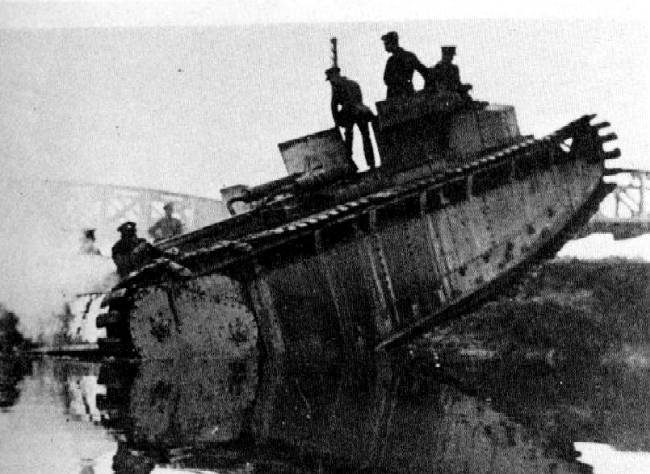
The car could climb the uncool shore.
The development of the Medium D project was completed after the end of the First World War. Despite the truce and the peace treaty signed later, the UK needed new armored vehicles, which led to the continuation of work on a number of projects. In 1920, the first prototype was built, intended for testing. Soon this car was sent to the landfill, where it was planned to check its driving performance. It should be noted that at that time the prototype did not have weapons. However, the absence of relatively light machine guns could hardly have a noticeable effect on the main characteristics.
At the site, the tank confirmed the calculated characteristics. He developed the highest speed for his time and could overcome various obstacles, including unacceptably difficult for other armored vehicles. The most important difference from other tanks of the time was the possibility of navigation. Checks and assessments of weapons were not conducted because of his absence.
At the same time, shortcomings directly related to obtaining high technical characteristics were identified. Tank Mark D was very difficult to manufacture and operate. First and foremost, difficulties of one kind or another arose during the assembly and maintenance of the over complicated chassis. Also, in some situations, there could be problems with maneuverability associated with a large length of tracks and the base of the chassis.
Checks and finishing the tank in the base configuration lasted for several months. Initially, tests were carried out only on land, but in 1921, an experienced Medium Tank Mark D went to the reservoir for the first time. First, the testers checked the capabilities of the armored vehicle in moving around the ford. Later, after some minor improvements, an attempt was made to make the tank completely floating. In the course of the checks that followed, it was found that the machine has a certain potential in such a context, but its implementation is associated with a lot of difficulties.
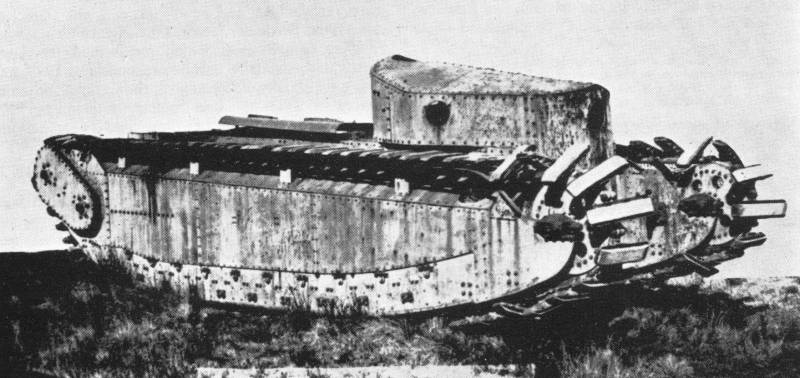
Medium Tank Mark D Second Prototype
The tank was really able to float without using any additional means. Rewinding the tracks, he could swim at a speed of about 5 km / h. However, the draft was unacceptably high. During the tests on the water, the machine was noticeably lightened, but in this form it sank to the level of the axles of the guides and driving wheels. Installing all the armor and weapons would necessarily lead to an additional loss of reserve buoyancy. As a result, the tank was afraid of even a little excitement. For launching and going ashore, the car needed a flat section of the bottom and the beach with sufficient hardness that still needed to be found.
The proposed medium tank “D” was distinguished by high characteristics of mobility and maneuverability, but it was not deprived of noticeable flaws. Armament and armor were not powerful enough, and the assembly and operation were associated with a lot of problems. The real advantages over the existing equipment were either absent or overlapped by shortcomings and lag in certain characteristics. Such an armored vehicle was not of interest to the British army. In 1921, the military department stopped showing a clear interest in the Medium Tank Mark D project, and alternative designs began to receive more support.
However, work on this project did not stop immediately. Taking into account the experience of the tests and the critics of the customer, attempts were made to upgrade the existing machine. Soon, two new versions of the medium tank appeared. According to some reports, the verification of new projects was carried out using an existing prototype. It was rebuilt twice in one way or another, and each time they received some improvement in performance. In this case, there is reason to believe that new projects were tested using one or two separate prototypes.
The first upgrade option was designated Medium Tank Mark D *. It is known that this project offered a slight update of the chassis. Apparently, it was about simplifying the existing design with the optimization of suspension systems, but with the simultaneous preservation of the overall architecture. According to some reports, such processing has led to a change in the design of the side plates and the reassembly of the devices they are closing.
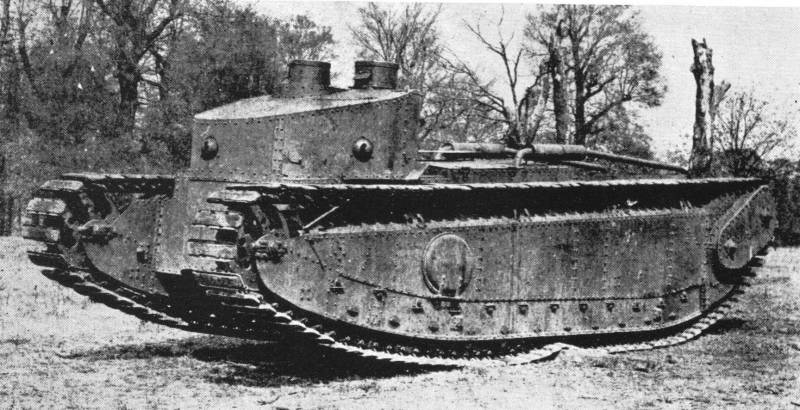
Experienced armored vehicle, rebuilt by the project Medium Tank Mark D **
The next project Medium Tank Mark D ** provided for a new refinement of the chassis and affected the superstructure design. The latter received an additional turret with viewing slots, which made it possible to raise the awareness of the crew. The second turret was placed in front of the roof that was on a special superstructure. Chassis received updated tracks. They retained the skeletal structure, but the transverse elements could now swing relative to the main chain. This should have to some extent improved the distribution of the weight of the car to the ground and increased throughput.
Two upgrades of the Mark D tank allowed a certain increase in technical and operational characteristics, but did not lead to the desired results. By the time of the appearance of a modification with two asterisks in the title, the military department had time to review the existing proposals and draw conclusions. The medium tank Medium Tank Mark I, developed by Vickers, was recommended for use. The armored vehicle under the letter “D” lost all chances to get into the troops.
Probably, based on the desire to bring the existing developments to practical application, the authors of the Medium Tank Mark D project used it as a basis for new types of armored vehicles. In the same year, 1921 created new armored vehicles based on an existing project. They differed in other sizes, and also had other onboard equipment. However, such developments did not allow the existing concepts to be brought to mass production and subsequent operation in the army.
The built prototype (or prototypes) was sent for storage. It is known that he remained at the Bovington proving ground, at least until the end of the twenties. Later, the car was disposed of as unnecessary. Now an experienced medium tank Medium Tank Mark D can be seen only in the few remaining photographs.
The aim of the Medium Tank Mark D project was to create a promising medium tank, combining all the best qualities of the existing technology. The tasks were successfully solved, but the price of this was unacceptable complexity of design and operation. Other samples of similar purpose, developed in parallel with the tank “D”, had fewer flaws, which determined the final choice of the military. The designers tried to modernize the medium tank or make it the basis for new armored vehicles of a different class, but all these attempts did not affect the future re-equipment of the army either, although they left a noticeable mark in the history of British tank design.
